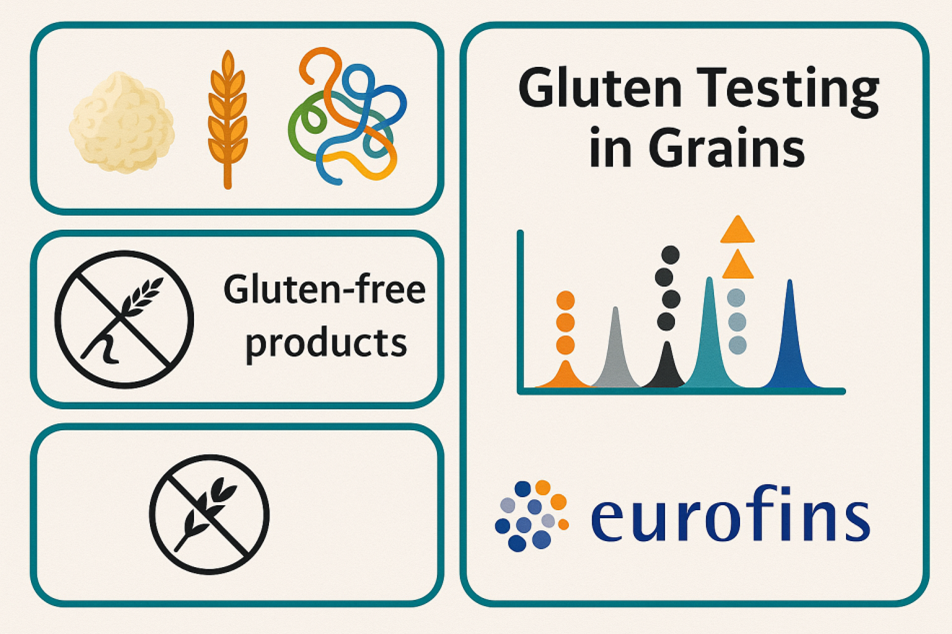Gluten testing in grains

Introduction
Gluten is a mixture of storage proteins, mainly gliadin and glutenin, that occurs naturally in wheat, barley, rye, and their hybrids. It contributes elasticity to dough and provides structure to baked goods. However, gluten can cause serious health issues in individuals with celiac disease, non-celiac gluten sensitivity, or wheat allergy. Even very small amounts can trigger immune reactions in sensitive individuals, making reliable gluten testing a vital part of food safety and quality control.
Eurofins provides advanced testing services to help food producers, exporters, and importers ensure gluten safety, accurate product labeling, and compliance with international regulations.

Why Gluten Testing Must Be Done
At Eurofins, we recognize the importance of testing grains and grain-based products for gluten to:
- Protect consumer health, particularly individuals with celiac disease or gluten sensitivity.
- Verify gluten-free product claims (<20 ppm gluten).
- Ensure compliance with Codex Alimentarius, FSSAI, FDA, EFSA, and global guidelines.
- Detect cross-contamination in naturally gluten-free grains like rice, maize, sorghum, millet, and quinoa.
- Safeguard exports and imports from trade barriers and recalls.
Health effects of gluten:
While gluten is harmless for most people, it can trigger severe reactions in those with celiac disease, an autoimmune disorder that damages the small intestine upon gluten ingestion. Common symptoms associated with gluten sensitivity include:
- Diarrhea
- Bloating
- Fatigue
- Unintentional weight loss
- Anaemia
- Nutritional deficiencies
Common Gluten Sources and Risk of Contamination
|
Grain/Product |
Gluten Status |
Risk of Cross-Contamination |
|
Wheat, Rye, Barley |
Naturally contains gluten |
High – direct gluten proteins |
|
Oats |
Naturally gluten-free |
High – often contaminated with wheat during harvest/storage |
|
Rice, Maize, Sorghum, Quinoa, Millet |
Naturally gluten-free |
Moderate – cross-contact in milling/transport |
|
Processed Foods (bread, pasta, sauces, snacks) |
Depends on recipe |
Very High – multiple additives and shared equipment |
Standards and Regulations
FSSAI
- Gluten Limits: Under FSSAI guidelines, products can be labeled as "gluten-free" if they contain 20 mg/kg or less of gluten. This standard aligns with international norms, including those set by Codex Alimentarius.
- Labelling Requirements: The term "gluten-free" must be prominently displayed near the product name on packaging. FSSAI is also working on provisions to address cross-contamination issues.
https://www.fssai.gov.in/upload/uploadfiles/files/Guidance_Note_Ver2_Gluten_Free_31_10_2019_Revised_10_02_2020.pdf
European Union Regulations
Commission Implementing Regulation (EU) No 828/2014
- Purpose: This regulation establishes harmonized requirements for labeling food products as "gluten-free" or "very low gluten."
- Gluten Limits: Foods labeled as "gluten-free" must contain no more than 20 mg/kg of gluten, while "very low gluten" products can contain between 20 mg/kg and 100 mg/kg.
- Scope: The regulation applies to both pre-packaged and non-pre-packaged foods, including those served in restaurants, expanding consumer protection for those with gluten intolerance
- https://eur-lex.europa.eu/eli/reg_impl/2014/828/oj
Types of Gluten Testing We Offer
Eurofins provides one of the most comprehensive suites of gluten testing methods:
- ELISA (Enzyme-Linked Immunosorbent Assay) – gold-standard method for detecting gluten proteins, widely used for routine screening.
- Lateral Flow Devices (Rapid Kits) – quick checks for on-site gluten presence in production environments.
- LC-MS/MS (Liquid Chromatography with Tandem Mass Spectrometry) – highly precise method for confirmatory gluten detection in complex food matrices.
- DNA-based PCR techniques – identify wheat, barley, or rye contamination at the molecular level.
All testing is performed in ISO/IEC 17025-accredited laboratories following globally harmonized QA/QC protocols.
Common Issues We Help Clients Solve
|
Issue |
How Eurofins Helps |
|
Cross-contamination in naturally gluten-free grains |
Detection using ELISA and LC-MS/MS methods |
|
Non-compliant gluten-free labelling |
Verification against Codex, FSSAI, FDA, EFSA standards |
|
False “gluten-free” claims in exports |
Certification support and compliance documentation |
|
Complaints, recalls, or rejections at customs |
Rapid testing, root-cause analysis, and retesting |
Case Study: Supporting an Exporter of Rice-Based Products
A rice flour manufacturer seeking to export to the EU approached Eurofins for gluten testing. Our ELISA and LC-MS/MS analysis revealed trace contamination from shared milling equipment. With our guidance, the client implemented corrective measures, and repeat testing confirmed compliance with the <20 ppm requirement. This enabled smooth entry into the European market with gluten-free certification.
Why Choose Eurofins for Gluten Testing?
- Global network with more than 900 laboratories across 50+ countries.
- NABL, ISO/IEC 17025, and internationally accredited testing facilities.
- State-of-the-art analytical platforms: ELISA, LC-MS/MS, PCR.
- Expertise from food scientists, technologists, and regulatory specialists.
- End-to-end support for labeling, export/import compliance, and certification.
Call to Action
- Partner with Eurofins to ensure your grains and products meet gluten-free safety standards..
- Schedule gluten testing now to protect consumers and safeguard your business.
Enquiry now: https://www.eurofins.in/food-testing/enquire-now/


